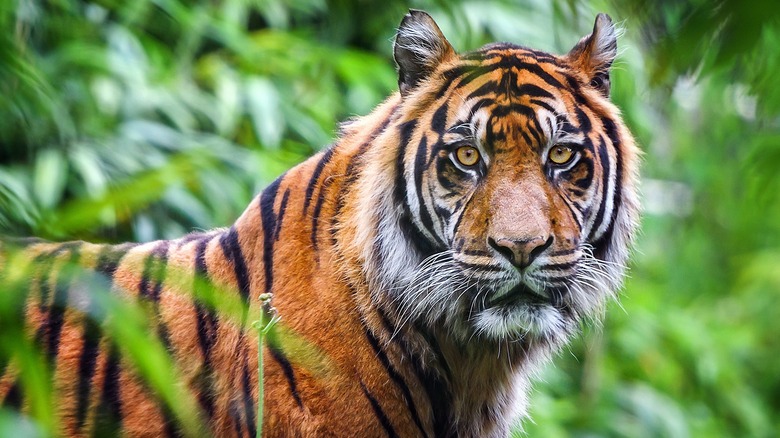Enjoy incredible wildlife encounters
If you’re passionate about wildlife conservation and can’t wait to set your sights on some spectacular species, Sumatra is a place to embrace the experience. The island is home to the endangered Sumatran orangutan and the Sumatran tiger, too. You’ll also be within reach of the smallest Asian elephant on the planet when you head this way, along with the critically endangered Sumatran rhino whose population numbers less than 300 worldwide.
An exciting and safe route to relishing wildlife sightings across Sumatra is to explore nature in a national park or two while you’re here. In North Sumatra, a must-visit destination is the Gunung Leuser National Park. Visitors have a chance to explore sprawling tropical rainforests and enjoy a protected habitat for Sumatran orangutans. It’s also home to sun bears, Sumatran elephants, tigers, rhinos, and hornbills. The best time to visit and enhance your chances of spotting wildlife is during the dry season which runs from May to September.
Sprawling across 5,000 miles of western and southern Sumatra terrain, Kerinci Seblat is the largest national park on the island. Towering Mount Kerinci tempts climbers in this direction and the park is also where you’ll find Sumatra’s largest tiger population. They’re accompanied by elephants, monkeys, civets, tapirs, and leopards so there’s a lot to keep your eyes open for. If you head southeast and stop at Way Kambas National Park, you’ll be able to access Sumatra’s Elephant Conservation Center and the Sumatra Rhino Sanctuary.
Natural landmarks and plants to discover

The wildlife across Sumatra easily captivates the minds and imaginations of travelers, but nature enthusiasts will find the island is just as abundant in natural landmarks and other-worldly plants. One you’ll want to see for yourself is Danau Toba. Often referred to as Toba Lake, this body of water spans over 670 miles and is the largest lake in Southeast Asia. The view here is undeniably impressive and the surrounding megaliths only enhance the scenery.
A colorful if not fragrant experience in nature waits for you in Sumatra’s city of Bengkulu. Situated seaside, Bengkulu has the unique distinction of being a place where you can see a massive parasitic flower known as Rafflesia Arnoldii up close. That said, getting close is a risk as these flowers bloom nearly 3 feet wide, weigh up to 15 pounds, and release a rancid odor that attracts pollinating flies and beetles. If you’re willing to face the aroma, the best place to see the blooms is at the Dendam Tak Sudah Botanical Gardens, near Dendam Tak Sudah Lake, just 5 miles from Bengkulu.
When you’re ready to turn your nature-focused getaway to Sumatra into reality, getting here is fairly straightforward. International travelers typically fly into Medan which is Sumatra’s largest city and serves several incoming flight routes from Kuala Lumpur and Singapore. If you can, make travel plans between April and October. Sumatra’s rainy season runs from November through March and monsoons can cause travel disruptions.

